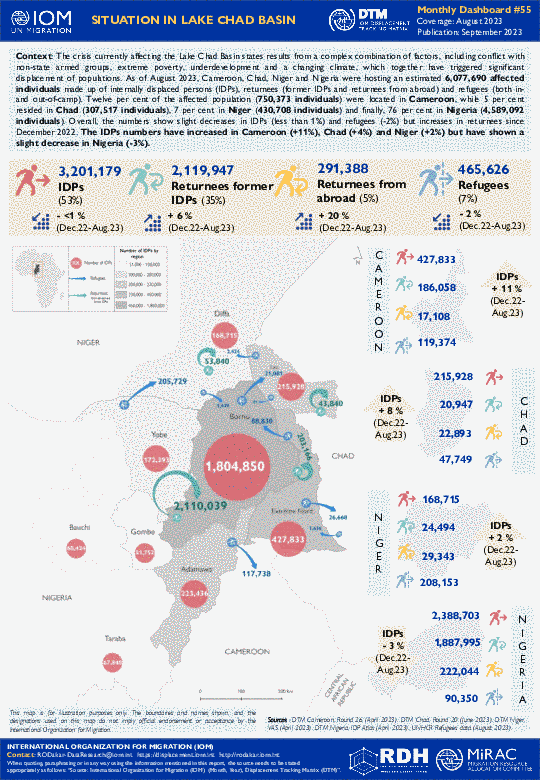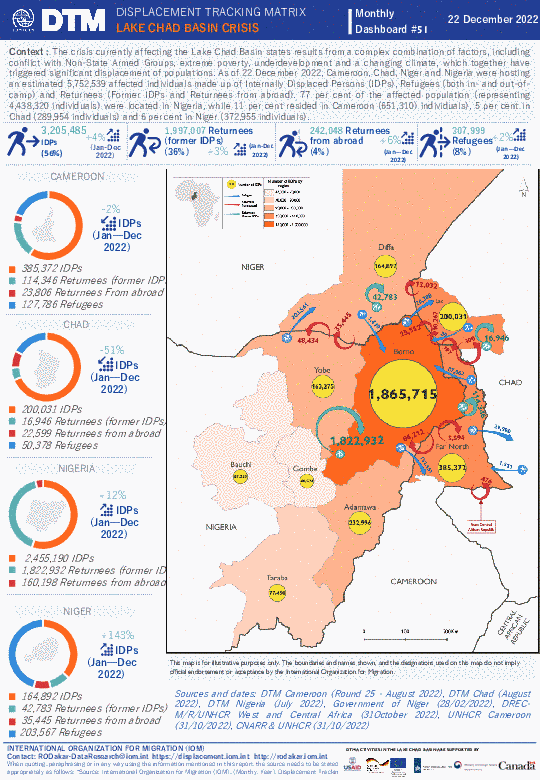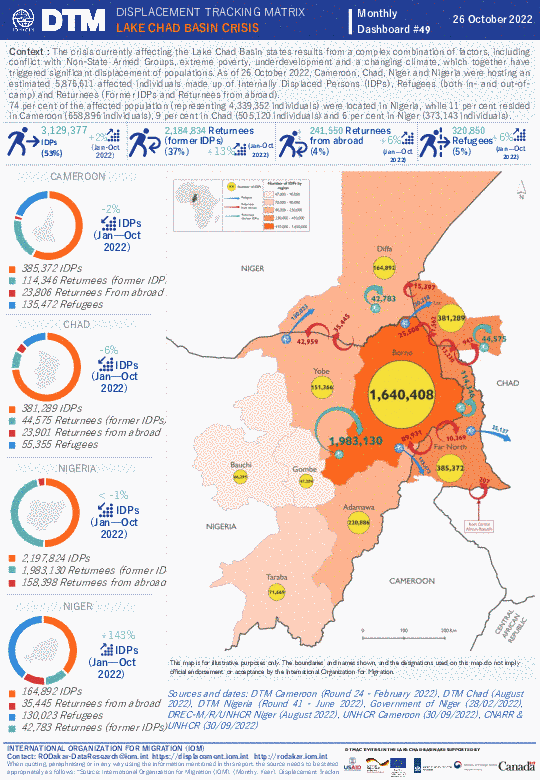-
Countries
-
Data and Analysis
-
Special Focus
-
Crisis Responses
Lake Chad Basin Crisis Monthly Dashboard
Title Standard
West and Central Africa — Lake Chad Basin Crisis Monthly Dashboard # (DATE)
Operation
Contact
Regional Office Dakar, RODakar-DataResearch@iom.int
Type
Component
Domain
Confidential
Region
The crisis currently affecting the Lake Chad Basin states results from a complex combination of factors, including conflict with non-state armed groups, extreme poverty, underdevelopment and a changing climate, which together have triggered significant displacement of populations. As of August 2023, Cameroon, Chad, Niger and Nigeria were hosting an estimated 6,077,690 affected individuals made up of internally displaced persons (IDPs), returnees (former IDPs and returnees from abroad) and refugees (both in- and out-of-camp).
The Central African Republic (CAR), which has experienced continuous volatility for the past two decades, has been riddled by a crisis which ignited in 2012 with a violent takeover of power and has developed into a complex protracted state of permanent insecurity and fragility which has spilled over into neighbouring countries. The crisis is characterized by power struggles amongst elites, the absence of state institutions and public investment, religious and ethnic tensions and disputes for the control of key resources. More recently, the crisis in Sudan, which started in April 2023, is affecting the eastern part of the CAR witnessing arrivals of displaced populations. As of July 2023, 3,831,877 individuals were affected, including 485,825 internally displaced persons (13% of the displaced population), 2,063,885 returnees former IDPs (54%), 503,019 returnees from abroad (13%) and 779,148 refugees (20%). In the CAR, the largest displaced population consists of former IDP returnees. Refugees from the CAR are primarily hosted by Cameroon (350,428 individuals, or 45% of the refugees), the Democratic Republic of the Congo (DRC) (210,552 individuals, or 27% of the refugees) and Chad (127,934 individuals, or 16% of the refugees). Nonetheless, 24,370 refugees from the Central African Republic are still living in Sudan (3% of the refugees). Since the beginning of the Sudan crisis, a total of 4,071 Central Africans have returned to their country of origin through the border in Am-Dafock, representing 4 per cent of returns from abroad. In addition, the CAR is also home for refugees from neighbouring countries, hosting a total of 33,209 refugees coming from Sudan (22,768 individuals), the DRC (6,384 individuals), South Soudan (2,726 individuals) and Chad (1,331 individuals).
The crisis currently affecting the Lake Chad Basin states results from a complex combination of factors, including conflict with non-state armed groups, extreme poverty, underdevelopment and a changing climate, which together have triggered significant displacement of populations. As of July 2023, Cameroon, Chad, Niger and Nigeria were hosting an estimated 6,065,751 affected individuals made up of internally displaced persons (IDPs), returnees (former IDPs and returnees from abroad) and refugees (both in- and out-of-camp).
The crisis currently affecting the Lake Chad Basin states results from a complex combination of factors, including conflict with non-state armed groups, extreme poverty, underdevelopment and a changing climate, which together have triggered significant displacement of populations. As of June 2023, Cameroon, Chad, Niger and Nigeria were hosting an estimated 6,061,037 affected individuals made up of internally displaced persons (IDPs), returnees (former IDPs and returnees from abroad) and refugees (both in- and out-of-camp).
The crisis currently affecting the Lake Chad Basin states results from a complex combination of factors, including conflict with non-state armed groups, extreme poverty, underdevelopment and a changing climate, which together have triggered significant displacement of populations. As of May 2023, Cameroon, Chad, Niger and Nigeria were hosting an estimated 6,057,885 affected individuals made up of internally displaced persons (IDPs), returnees (former IDPs and returnees from abroad) and refugees (both in- and out-of-camp).
The crisis currently affecting the Lake Chad Basin states results from a complex combination of factors, including conflict with Non-State Armed Groups, extreme poverty, underdevelopment and a changing climate, which together have triggered significant displacement of populations. As of 22 December 2022, Cameroon, Chad, Niger and Nigeria were hosting an estimated 5,752,539 affected individuals made up of Internally Displaced Persons (IDPs), Refugees (both in- and out-of-camp) and Returnees (Former IDPs and Returnees from abroad). 77 per cent of the affected population (representing 4,438,320 individuals) were located in Nigeria, while 11 per cent resided in Cameroon (651,310) individuals), 5 per cent in Chad (289,954 individuals) and 6 per cent in Niger (372,955 individuals).
The crisis currently affecting the Lake Chad Basin states results from a complex combination of factors, including conflict with Non-State Armed Groups, extreme poverty, underdevelopment and a changing climate, which together have triggered significant displacement of populations. As of 30 November 2022, Cameroon, Chad, Niger and Nigeria were hosting an estimated 6,034,686 affected individuals made up of Internally Displaced Persons (IDPs), Refugees (both in- and out-of-camp) and Returnees (Former IDPs and Returnees from abroad). 73 per cent of the affected population (representing 4,427,934 individuals) were located in Nigeria, while 11 per cent resided in Cameroon (654,136) individuals), 8 per cent in Chad (505,928 individuals) and 7 per cent in Niger (446,687 individuals).
La crise dans le Bassin du lac Tchad est le résultat d’une combinaison complexe d’une multitude de facteurs, y compris un conflit armé impliquant des groupes armés non étatiques, des niveaux extrêmes de pauvreté, un sous-développement persistant, et des bouleversements climatiques, qui ont conduit à des déplacements de populations importants. Au 26 Octobre 2022, le Cameroun, le Tchad, le Nigeria et le Niger accueillaient 5 876 611 individus affectés par la crise, dont des Personnes déplacées internes (PDI), des réfugiés et des retournés (anciennes PDI et retournés de l’étranger). 74 pour cent d’entre eux (soit 4 339 352 personnes) se trouvaient au Nigéria, 11 pour cent au Cameroun (658 896 personnes), 9 pour cent au Tchad (505 120 personnes) et 6 pour cent au Niger (373 143 personnes).
The crisis currently affecting the Lake Chad Basin states results from a complex combination of factors, including conflict with Non-State Armed Groups, extreme poverty, underdevelopment and a changing climate, which together have triggered significant displacement of populations. As of 26 October 2022, Cameroon, Chad, Niger and Nigeria were hosting an estimated 5,876,611 affected individuals made up of Internally Displaced Persons (IDPs), Refugees (both in- and out-of-camp) and Returnees (Former IDPs and Returnees from abroad).
74 per cent of the affected population (representing 4,339,352 individuals) were located in Nigeria, while 11 per cent resided in Cameroon (658,896 individuals), 9 per cent in Chad (505,120 individuals) and 6 per cent in Niger (373,143 individuals).
La crise dans le Bassin du lac Tchad est le résultat d’une combinaison complexe d’une multitude de facteurs, y compris un conflit armé impliquant des groupes armés non étatiques, des niveaux extrêmes de pauvreté, un sous-développement persistant, et des bouleversements climatiques, qui ont conduit à des déplacements de populations importants. Au 30 septembre 2022, le Cameroun, le Tchad, le Nigeria et le Niger accueillaient 5 828 247 individus affectés par la crise, dont des Personnes déplacées internes (PDI), des réfugiés et des retournés (anciennes PDI et retournés de l’étranger). 74 pour cent d’entre eux (soit 4 339 352 personnes) se trouvaient au Nigéria, 11 pour cent au Cameroun (653 316 personnes), 9 pour cent au Tchad (512 411 personnes) et 6 pour cent au Niger (323 168 personnes).
Pagination
- Page 1
- Next page










